Table of contents
The green kiwi ( Actinidia deliciosa ) is characterized by its characteristic taste and striking coloring. When eaten raw, it contains many vitamins (especially vitamin C), minerals and few calories. Kiwis are usually also available organically .
Use in the kitchen
What does a kiwi taste like? A kiwi tastes sweet and sour. It is reminiscent of a mixture of gooseberry , melon and strawberry .
In addition to the green kiwi described here, there are other varieties (or species) that differ in size, taste, flesh color and hairiness of the skin (see chapter: Further information, Alternative names).
Kiwis are best enjoyed raw. They can also be used to make jam, chutneys, juice, syrup or vegan cakes. They are great for breakfast in muesli (e.g. in omega-3-rich pea muesli ), in porridge or as a raw food smoothie (e.g. in combination with spinach or banana ). They are used savourily as an exotic flavour in salads, in salsa (e.g. with pistachios ) or in a sauce with walnuts . The green kiwi is used as a dessert in vegan pudding with chia seeds , as a cream with mangos or as a kiwi muffin.
To eat a kiwi raw, cut it in half and scoop it out - or peel and cut it into pieces. Organic kiwis can also be eaten with the skin on, and eating it is even recommended. It contains more secondary plant substances (see below) and fiber. 3,15 If the skin of a green kiwi is too hairy for you, you can try a smoother yellow or golden kiwi. 3
The interaction of raw kiwis and dairy products produces a bitter taste, as the enzyme actinidin in kiwis breaks down the milk protein and thus changes the taste. This can be remedied by switching to vegan products or briefly heating the kiwi, which inactivates the enzyme. 10 Several varieties of golden kiwis contain the enzyme in lower concentrations or not at all. 6
Vegan recipe for a low-calorie kiwi ice cream
Ingredients (for 8 servings): 6-8 kiwis (green, organic), 1 lime (organic), 1-2 tablespoons agave syrup (depending on desired sweetness and ripeness of the kiwis).
Preparation: Peel the raw organic kiwis and cut one of the peeled kiwis into thin slices. Squeeze the lime and puree it together with the remaining kiwis and the agave syrup. Fill the ice cream molds with kiwi slices and add the fruit puree. Place everything in the freezer for about 30 minutes. Then place the ice cream sticks in the middle and freeze again for at least 3 hours.
Vegan recipe for a kiwi chutney
Ingredients (for 8 servings): 4 green kiwis (organic), 1 vegetable onion , 1 tbsp rapeseed oil , 1 tsp corn starch (for the consistency), 50 ml pear juice, 5 cloves , 2 tbsp vinegar (preferably balsamic vinegar ), 1 tbsp agave syrup (optional).
Preparation: Dice the raw organic onion and sauté in the pan with the rapeseed oil. As soon as the onion is golden brown, deglaze with vinegar and pear juice and bring to the boil briefly. Peel and dice the green kiwis and add them to the pan together with the cloves and agave syrup if necessary. Simmer the mixture for approx. 5-8 minutes on a low heat. Then remove the cloves and stir in corn starch for a better consistency. Finally, bring the vegan chutney to the boil again briefly.
Vegan recipes with kiwi (green, raw) can be found under the note: " Recipes that have the most of this ingredient "
| Not only vegans or vegetarians should read this: Vegans often eat unhealthily. Avoidable nutritional mistakes . |
Purchasing - Storage
Green kiwis can be found all year round in conventional and organic quality in most supermarkets such as Coop , Migros , Spar , Aldi , Lidl , Rewe , Edeka , Hofer , Billa etc.). The same applies to organic supermarkets ( Denn's Biomarkt and Alnatura ). Depending on the size of the store, stores such as Denner and Volg only offer some of the fruit all year round. The green kiwi is imported to Europe in spring and summer from the southern hemisphere (especially New Zealand and Chile). In autumn and winter it comes from southern Europe (such as Italy, Greece and France), as that is when the kiwi is in season in Europe.
The optimal degree of ripeness can be felt: the fruit gives way slightly when gently pressed without leaving permanent bruises. A cut kiwi is then juicy and aromatic. However, if the ideal degree of ripeness is exceeded, the kiwi feels very soft and the flesh is glassy. The aroma also changes from sweet and sour to rotten and sweet. Unripe kiwis are hard and have dry, matt green flesh. They taste very sour.
The availability of raw green kiwis varies depending on the size of the store, catchment area, etc. Our recorded food prices for the DA-CH countries can be found above under the ingredient image - and by clicking you can see their development at various suppliers.
Storage tips
Unripe kiwis can be stored for up to 6 months at 0 °C. They will keep for several weeks in the fridge. Before consumption, store them at room temperature until they are soft and ripe. If you store green kiwis together with other fruits (such as apples) that emit ethylene gas, the ripening process will speed up. Kiwis themselves also emit ethylene gas. Therefore, it is best to separate very ripe or damaged kiwis from the rest after purchase. Ripe kiwis will keep for up to a week. Eat cut fruit as quickly as possible or store it briefly in the fridge in an airtight container.
Ingredients - Nutritional Values - Calories
Information on ingredients (or nutritional values) of a kiwi is usually based on ripe fruit flesh without the peel. 3
What nutrients does a green kiwi have? The raw green kiwi contains 61 kcal per 100 g. 1 The average weight of a kiwi is 75 g, which gives you around 46 kcal per piece. 14 The macronutrients are divided into 15 g carbohydrates, 1.1 g protein and 0.52 g fat per 100 g kiwi fruit. The 15 g carbohydrates in the green kiwi consist of 9 g sugar and 3 g fiber.
What vitamins does a green kiwi have? Green kiwis are a good source of vitamin C, vitamin K, vitamin B 9 (folate) and vitamin E. They also contain various bioactive components. 3 Studies have shown that kiwis contain important secondary plant substances such as carotenoids, flavonoids and polyphenols, which have antioxidant effects, among other things. 3,11
A raw green kiwi has an average of 93 mg of vitamin C (ascorbic acid) per 100 g, which corresponds to 116% of the daily requirement. A comparable amount is provided by raw pointed peppers (also 93 mg/100 g) and raw broccoli (89 mg/100 g); we could not find similar contents in any other fruit. The real guava contains 228 mg per 100 g, which is about 2.5 times as much vitamin C. 1
The vitamin K content of a green kiwi is 40 µg per 100 g, which covers 54% of the daily requirement. 1 This is mainly vitamin K 1 , as vitamin K 2 is mainly found in fermented or animal products. 2 Celeriac (raw) has a similar vitamin K value at 41 µg/100g, whereas raw spinach has 12 times more vitamin K at 483 µg/100g. The green kiwi is the fruit that contains the most vitamin K when fresh. 1
Green kiwis have 312 mg of potassium per 100 g. This corresponds to 16% of the daily requirement. This content is comparable to the raw American persimmon (310 mg/100g) and the Galia melon (309 mg/100g). Spinach contains almost twice as much potassium at 558 mg/100g. Foods that provide the most potassium are often spices or herbs (eg dried parsley : 2683 mg/100g). However, only small amounts of these are consumed. 1
How healthy are yellow kiwis? Compared to green kiwis, yellow or golden kiwis ( Actinidia chinensis ) contain more vitamin C and vitamin B 9 (folate). The values for potassium and vitamin E hardly differ. 3
The total ingredients of a raw kiwi (green), the coverage of the daily requirement and comparison values with other ingredients can be found in our nutrient tables. In the article Nutrients explained you will get a detailed insight into the topic.
Effects on health
Kiwi fruits are particularly healthy when eaten raw: you benefit most from the high vitamin C content and the folate they contain, as both substances are sensitive to heat. A high vitamin C content can, among other things, improve the bioavailability of iron and plays an important role in a functioning immune system. 3
The ingredients in green kiwis support digestion by, among other things, increasing the fullness and softness of stools. It is also believed that kiwifruit helps with constipation, which can be caused by a lack of fiber. 3 Two green kiwis a day provide around 4.5 g of fiber. 1 With a daily recommendation of 28 g per 2000 kcal (14 g/1000 kcal) 4 , this corresponds to just over a sixth of the recommended amount (16%).
Eating the skin increases the intake of antioxidant secondary plant substances, fiber and vitamin E. 3 A 2019 study showed significantly higher results in terms of polyphenol and flavonoid content in the peel of golden kiwis. 15 In addition, a randomized controlled study was able to show that golden kiwis with the peel have a more positive effect on the digestive tract in irritable bowel syndrome (IBS) than bare fruit flesh. According to the authors, this can also be applied to green kiwis. 17
Various studies have observed that eating kiwis has a positive effect on blood pressure. Kiwis are also said to have a positive effect on cholesterol levels. This is shown by an increase in HDL cholesterol and a better ratio between HDL, LDL cholesterol and triglycerides. 3 However, science is not entirely unanimous on this: Another study suggests that kiwis have no significant effect on metabolic health (e.g. blood pressure) in participants with cardiovascular risk factors. 5
Due to their low glycemic index, kiwis are well suited to diabetic diets. 9
The enzyme actinidin contained in the green kiwi is known to promote the breakdown of animal protein (see Use in the kitchen). However, according to an in vitro digestion model, actinidin also improves the breakdown of plant proteins (eg from tofu, quinoa, pea protein). Faster breakdown leads to better protein digestion. 6
The seeds of the green kiwi are considered to be blood-thinning because they contain vitamin E and omega-3 fatty acids. 9
Organically grown kiwifruit has a higher mineral content, more vitamin C and more polyphenols. This leads to a higher antioxidant activity. 19
Dangers - Intolerances - Side effects
The green kiwi has a variety of positive ingredients and effects. However, kiwis are also one of the most common triggers of food allergies worldwide. The so-called kiwi allergy is caused by an abnormal immune reaction to kiwi proteins and occurs after consumption. The symptoms range from oral allergy syndrome (such as itching or burning) to skin reactions (such as redness, rash) to life-threatening anaphylaxis. Some of the allergens contained in the green kiwi depend on the degree of ripeness, which is why they are more prevalent in ripe kiwis. Processing methods such as steaming help to reduce the allergenicity of kiwis. 7
Folk medicine - naturopathy
In traditional Chinese medicine ( TCM ), the root of the kiwi is used as an anti-hepatotoxin and against gingivitis, among other things. The kiwi is said to help as a traditional folk remedy against diseases such as hepatitis, rheumatologic arthritis and certain types of cancer. 11
Ecological footprint - animal welfare
The CO 2 footprint of packaging and transport of kiwis from New Zealand varies depending on the type of packaging and target market. In Germany it amounts to 0.65-0.67 kg CO 2 eq per kg of imported fruit. Kiwis exported from New Zealand to Japan have an ecological footprint of around 0.33-0.4 kg CO 2 eq/kg. If we focus on efficient shipping in the future, use trains and ships instead of planes and use more sustainable packaging, the CO 2 balance will improve. 8 It also helps if consumers make sure to buy kiwis seasonally. In Europe the season is in autumn or winter. Then the kiwis mainly come from Italy, France or Greece, which means they have a shorter transport route.
The water footprint of kiwifruit production was measured in Turkey. A total of 8039 tonnes of kiwifruit were grown on 390 hectares, with an annual water footprint of 4,123,993 m 3 (approximately 513 litres per kg). In comparison, the water footprint of hazelnuts on the same area was determined to be significantly lower at 1,847,587 m 3 /year. Increased kiwifruit production can lead to water shortages depending on local conditions. In the region, it has therefore been suggested that hazelnut cultivation should be promoted instead of kiwifruit cultivation, as rainwater seems to be sufficient for this. 16 For New Zealand, an average water consumption of 417 litres per kg of kiwifruit produced was calculated. However, the study points to disagreements about the weighting of rainfall, water runoff and drainage. 20
Organic kiwis are free from chemical pesticides and synthetic fertilizers. They also ripen in mixed crops instead of monocultures. 18
Worldwide distribution - cultivation
The kiwifruit is native to China (probably in the southwest). In the last 100 years, the kiwi, which was originally a wild plant (Chinese gooseberry), has been domesticated. It is now an important cultivated plant. 3 In 1904, Isabel Fraser introduced kiwi seeds to New Zealand, where Hayward Wright bred the Hayward variety in the 1920s. which is now the most common fruit in the world. Kiwis were originally grown at home before commercial cultivation began in 1940. 11 In addition to New Zealand, kiwis also spread to Australia, Chile, the USA and Europe (especially Italy and Greece). 3 Today, Italy is the leading producer of kiwis, followed by New Zealand, Chile, France, Greece, Japan and the USA. 11,18
Cultivation in the garden
Actinidia deliciosa also grows in German-speaking countries in sheltered, warmer areas such as wine-growing regions. As a climbing plant, it covers house walls, fences or a pergola. If you plant it in the garden, the kiwi plant needs a climbing aid. The soil should be moist and slightly acidic, with a pH value between 5.5 and 6.5. The best time to plant is spring. 12,13 The kiwi begins to produce fruit when it is at least a year old and cross-pollination has taken place. For this, you need a female and a male plant. However, the sex can only be determined from a plant that is flowering, which is why it is worth planting several plants. 11 The harvest then takes place in November. 12
Kiwis also grow in pots. However, it should be noted that the green kiwi ( Actinidia deliciosa ) can reach a size of up to 10 metres, which is why it is sensible to consider slower-growing species such as Actinidia kolomikta for pot cultivation. This also has the advantage of being hardy and able to withstand temperatures down to -30 °C. 13
Further information
The green kiwi ( Actinidia deliciosa ) belongs to the family of Actinidiaceae and to the genus Actinidia . In total, this includes (55-60 11 ) or 76 species (depending on the classification), although only Actinidia chinensis (golden kiwi) and Actinidia deliciosa (green kiwi) are grown on a commercial scale. 9
Alternative names
The name kiwi - or kiwifruit in English - comes from New Zealand's heraldic animal, the kiwi. Like a kiwifruit, the kiwi is brown and furry, which is why Turners and Growers (a New Zealand food producer) renamed the Chinese gooseberry the kiwi. The Latin name is Actinidia deliciosa ; a common synonym remains Actinidia chinensis L., which also specifically refers to the golden kiwi. 11 This has the potential to be confusing.
Other names are macaque peach, mihoutau or Chinese gooseberry or Chinese spiny stylus. 9
The English language also uses the expressions fuzzy-skinned kiwi or fuzzy kiwi for green kiwis to refer to the hairiness, which is much stronger than in golden kiwis. 11

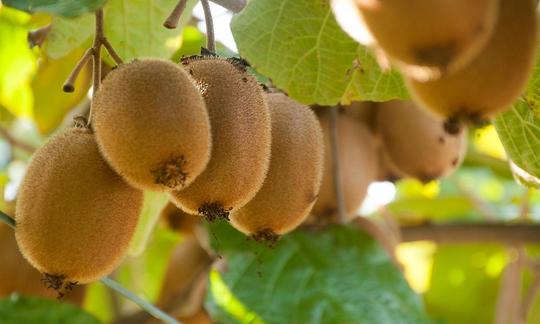

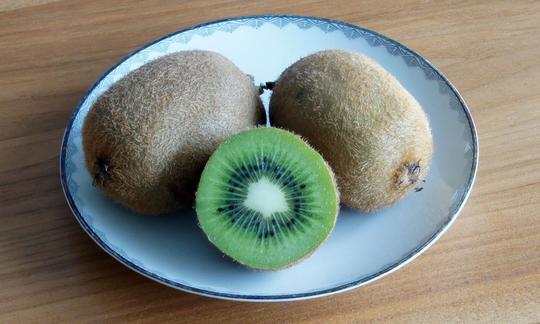

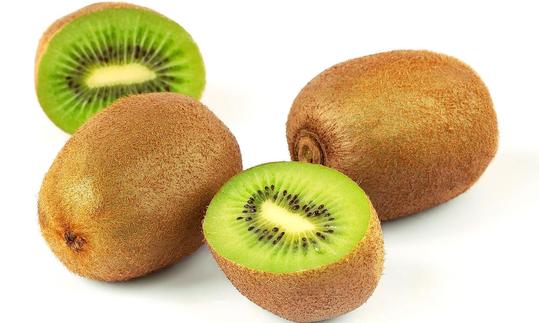

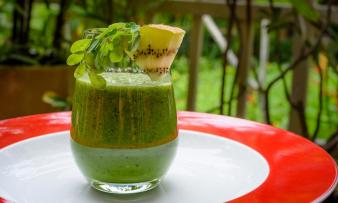
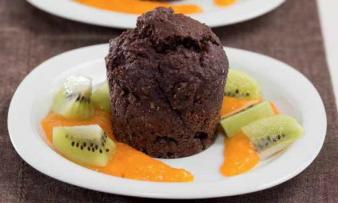
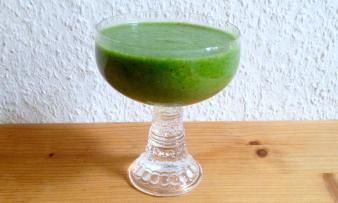





Comments